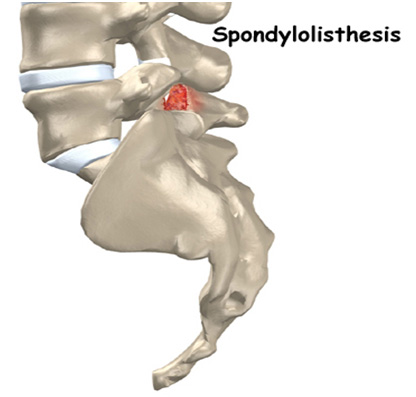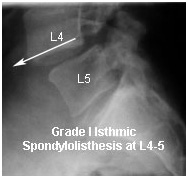
Lumber Spondylolisthesis
 Spondylolisthesis is a condition of the spine whereby one of the vertebra slips forward or backward compared to the next vertebra. Forward slippage of one vertebra on another is referred to as anterolisthesis, while backward slippage is referred to as retrolisthesis. Spondylolisthesis can lead to a deformity of the spine as well as a narrowing of the spinal canal (central spinal stenosis) or compression of the exiting nerve roots (foraminal stenosis).
Spondylolisthesis is a condition of the spine whereby one of the vertebra slips forward or backward compared to the next vertebra. Forward slippage of one vertebra on another is referred to as anterolisthesis, while backward slippage is referred to as retrolisthesis. Spondylolisthesis can lead to a deformity of the spine as well as a narrowing of the spinal canal (central spinal stenosis) or compression of the exiting nerve roots (foraminal stenosis).
Cause -
There are five major types of lumbar spondylolisthesis.
1. Dysplastic spondylolisthesis: Dysplastic spondylolisthesis is caused by a defect in the formation of part of the vertebra called the facet that allows it to slip forward. This is a condition that a patient is born with (congenital).
2. Isthmic spondylolisthesis: In Isthmic spondylolisthesis, there is a defect in a portion of the vertebra called the pars interarticularis. If there is a defect without a slip, the patient has spondylolysis. Isthmic spondylolisthesis can be caused by repetitive trauma and is more common in athletes exposed to hyperextension motions including gymnasts, and football linemen.
3. Degenerative spondylolisthesis: Degenerative spondylolisthesis occurs due to arthritic changes in the joints of the vertebrae due to cartilage degeneration. Degenerative spondylolisthesis is more common in older patients.
4. Traumatic spondylolisthesis: Traumatic spondylolisthesis is due to direct trauma or injury to the vertebrae. This can be caused by a fracture of the pedicle, lamina or facet joints that allows the front portion of the vertebra to slip forward with respect to the back portion of the vertebra.
5. Pathologic spondylolisthesis: Pathologic spondylolisthesis is caused by a defect in the bone caused by abnormal bone, such as from a tumor.
Risk Factor -
1. Family history of back problems.
2. History of repetitive trauma
3. Hyperextension of the lower back
4. Athletes such as gymnasts
5. Weight lifters
6. Football linemen (Isthmic spondylolisthesis)
Symptom -
1. Lower back pain. This is often worse after exercise especially with extension of the lumbar spine
2. Tightness of the hamstrings
3. Decreased range of motion of the lower back.
4. Numbness
5. Tingling or weakness in the legs due to nerve compression.
6. Severe compression of the nerves can cause loss of control of bowel or bladder function, or cauda equina syndrome.
7. Muscle spasms
Diagnose -
CT Scan, MRI
Spondylolisthesis is graded according the percentage of slip of the vertebra compared to the neighboring vertebra. 
Grade Level |
Amount of Displacement |
Grade I |
0% and 25% displacement of the vertebral body width |
Grade II |
25% to 50% displacement of the vertebral body width |
Grade III |
50% to 75% displacement of the vertebral body width |
Grade IV |
75% to 100% displacement of the vertebral body width |
Physiotherapy Treatment-
1. Rest from aggravating activities
2. Postural Training / Functional Training
3. ROM Exercises
4. Stretching Exercises
5. Strengthening Exercises
6. Stabilization
7. Manual Therapy
8. Back Brace - LSO
9. spinal traction

